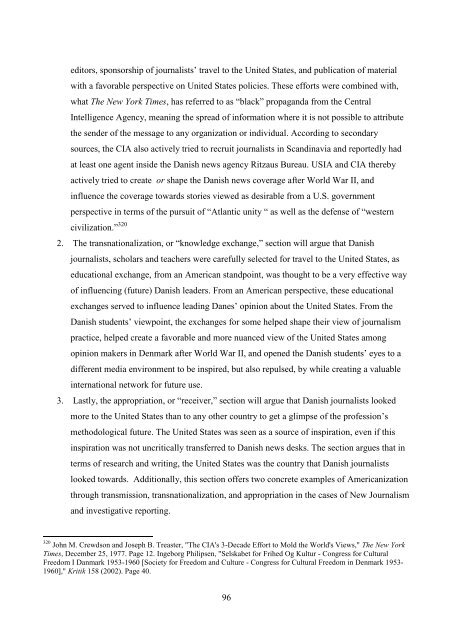The Jeremiad Over Journalism
The Jeremiad Over Journalism
The Jeremiad Over Journalism
You also want an ePaper? Increase the reach of your titles
YUMPU automatically turns print PDFs into web optimized ePapers that Google loves.
editors, sponsorship of journalists‘ travel to the United States, and publication of material<br />
with a favorable perspective on United States policies. <strong>The</strong>se efforts were combined with,<br />
what <strong>The</strong> New York Times, has referred to as ―black‖ propaganda from the Central<br />
Intelligence Agency, meaning the spread of information where it is not possible to attribute<br />
the sender of the message to any organization or individual. According to secondary<br />
sources, the CIA also actively tried to recruit journalists in Scandinavia and reportedly had<br />
at least one agent inside the Danish news agency Ritzaus Bureau. USIA and CIA thereby<br />
actively tried to create or shape the Danish news coverage after World War II, and<br />
influence the coverage towards stories viewed as desirable from a U.S. government<br />
perspective in terms of the pursuit of ―Atlantic unity ― as well as the defense of ―western<br />
civilization.‖ 320<br />
2. <strong>The</strong> transnationalization, or ―knowledge exchange,‖ section will argue that Danish<br />
journalists, scholars and teachers were carefully selected for travel to the United States, as<br />
educational exchange, from an American standpoint, was thought to be a very effective way<br />
of influencing (future) Danish leaders. From an American perspective, these educational<br />
exchanges served to influence leading Danes‘ opinion about the United States. From the<br />
Danish students‘ viewpoint, the exchanges for some helped shape their view of journalism<br />
practice, helped create a favorable and more nuanced view of the United States among<br />
opinion makers in Denmark after World War II, and opened the Danish students‘ eyes to a<br />
different media environment to be inspired, but also repulsed, by while creating a valuable<br />
international network for future use.<br />
3. Lastly, the appropriation, or ―receiver,‖ section will argue that Danish journalists looked<br />
more to the United States than to any other country to get a glimpse of the profession‘s<br />
methodological future. <strong>The</strong> United States was seen as a source of inspiration, even if this<br />
inspiration was not uncritically transferred to Danish news desks. <strong>The</strong> section argues that in<br />
terms of research and writing, the United States was the country that Danish journalists<br />
looked towards. Additionally, this section offers two concrete examples of Americanization<br />
through transmission, transnationalization, and appropriation in the cases of New <strong>Journalism</strong><br />
and investigative reporting.<br />
320 John M. Crewdson and Joseph B. Treaster, "<strong>The</strong> CIA's 3-Decade Effort to Mold the World's Views," <strong>The</strong> New York<br />
Times, December 25, 1977. Page 12. Ingeborg Philipsen, "Selskabet for Frihed Og Kultur - Congress for Cultural<br />
Freedom I Danmark 1953-1960 [Society for Freedom and Culture - Congress for Cultural Freedom in Denmark 1953-<br />
1960]," Kritik 158 (2002). Page 40.<br />
96
















